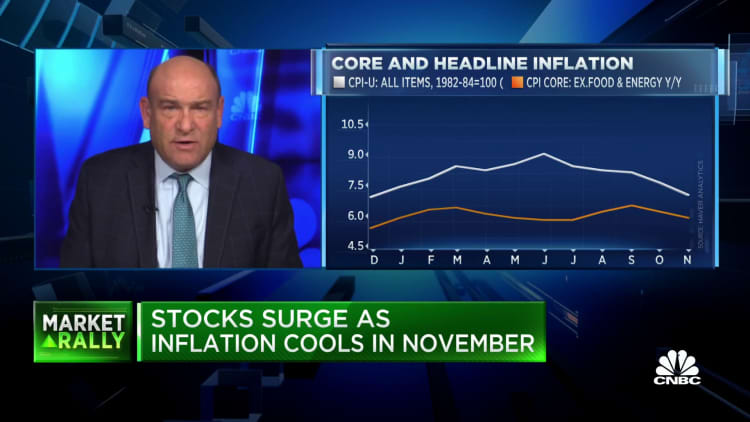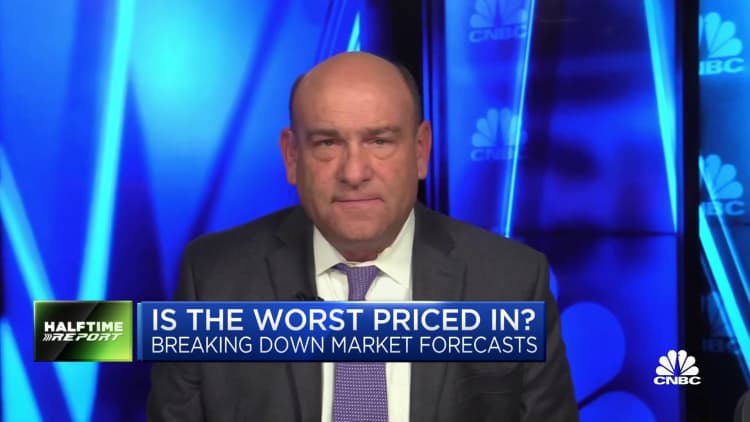The Federal Reserve as expected raised its benchmark interest rate by 50 basis points on Wednesday, and that does represent an easing in its recent rate-hiking path after multiple 75 percentage point hikes. But the Fed did not signal a major shift in its hawkish monetary policy, with the central bank upping its forecast for a peak rate of 5.1%. Hopes that the cooler than expected CPI data from this week might lead the Fed to reverse course sooner rather than later aren't taking into account what the Fed is watching closely in its inflation fight.
It's the labor market as much as the CPI, and employment data remains troubling for the Fed.
At Tuesday's CNBC CFO Council Fed Matters call with chief financial officers from major companies across the economy, signals of higher-than-average annual raises for 2023 speak to why the labor market strength may remain the bigger issue for the Fed than the consumer prices reflected by CPI this week. Multiple CFOs indicated on the call that employee raises will remain above the high two percent to low three percent annual merit pay increases that had been standard in recent labor market history. Recent data from compensation consultants has echoed this view, forecasting average raises above 4% again in 2023, after a 2022 that saw average raises reach as high as 4.8%. So a little cooler than last year, but still at a level that's far too high for comfort.

Even in Silicon Valley, where layoffs have been concentrated, CFOs say that the labor market is still running hot and there will be no return to a 3% merit raise budget for 2023. Inflation is down, but employee expectations are still high for raises because they have lost purchasing power.
"3.5% is the base case and it's going up," said one CFO on the call, which is conducted under Chatham House rules to allow CFOs to speak freely.
That, in turn, will put pressure on companies to keep using price as a lever to make back some of the margin lost to labor costs. And that raises the risk of the wage-price spiral that is one of the Fed's greatest fears in the inflation fight, a cycle in which wages rise in response to prices and prices rise in response to wages.
In some industries, recent gains made by union workers in annual pay, as high as 7% in some cases, will lead to additional pressure from white-collar workers for bigger raises, and while not nearly as high as the union deals, the expectation in a hot labor market is for raises to remain above 4% in these sectors.
There will be some ways in which bigger raises will do some of the Fed's work for it. Companies will likely be looking to offset the cost of higher annual wages by reducing headcount in select areas of their labor force and cutting underperformers, which gets at one of the Fed's primary goals: raising unemployment to a higher target level of 4%. Additionally, some firms will opt to offer one-time bonuses, which has become more common over the past few years, to reflect the inflationary pinch on workers. This approach to offering more pay doesn't tie them into salary increases which can't be easily reversed and also does not factor into the wage inflation trend for long.
CNBC's senior economics reporter Steve Liesman shared with CFOs a view that was "not necessarily bearish," but cautious as inflation comes down, and based on the three areas that Fed Chair Powell has signaled the central bank is watching: core goods inflation, ex-food and energy, which is coming down; housing inflation, which is coming down (rent growth is at least slowing), but will decline slowly; and the third, and arguably more important, core services inflation which remains stubbornly high and where the labor market is the key. This views positions the positive news on CPI inflation as only one piece of the puzzle, and not even the biggest piece as far as the Fed is concerned. And until the Fed sees that labor market inflation coming into line, the central bank is not likely to make a major move away from its tightening course.

Powell said at his press conference on Wednesday after the FOMC decision that sticky services inflation might cause the central bank to continue raising rates.
"There's an expectation really that the that the services inflation will not move down so quickly so that we'll have to stay at it," Powell said "So we may have to raise rates higher to get to where we want to go and that's really why we're writing down those high rates and why we're expecting that they will have to remain high for a time."
And Powell again referenced the extremely tight conditions in the labor market, which he has identified in recent comments as a key factor.
LPL Financial economist Jeffrey Roach told CNBC in response to the FOMC rate hike and policy statement, "We should not be surprised if the Fed revises the expected peak fed funds rate as inflation, including the sticky components, starts to moderate. Looking ahead, investors need to watch the inflation path for non-housing core services, which is clos[ely] tied to labor market conditions."
Even as the Fed as expected raised rates by a little less, the market remains of the view that the Fed will raise at least another 25 basis points early next year, and potentially up to 75 basis points in total more, ultimately reaching near or even above 5% at its peak rate — which the latest Fed "dot plot" on Wednesday backed up. Maybe more consequentially, the Fed will hold rates there for much of 2023. CNBC's recent Fed Survey finds market strategists and economists anticipating a Fed that holds rates in the range of 5% for nine months after reaching that level next March.
The stock market responded well to the CPI data this week, but recent history has shown that euphoria is not a good position for investors to be in when the Fed is fighting inflation. At his Jackson Hole speech in August, Powell made it clear to the markets that there was still a long way to go in the inflation battle, and with inflation still above 7% year over year, there's reason to expect that the Fed remains reluctant to signal that it feels like victory is within reach. It is likely that the Fed sends some version of the message that Powell has been harping on recently: it is a long battle to bring prices down, and it is as much about labor as consumer prices.






